Mineral Recycling Forum 2016 Review
Last month witnessed the successful launch of IMFORMED’s inaugural Mineral Recycling Forum held in Rotterdam during 14-15 March.
Over 100 delegates came away enriched with knowledge and new contacts for one of the fastest evolving industrial mineral sectors: raw materials from recycled waste products.
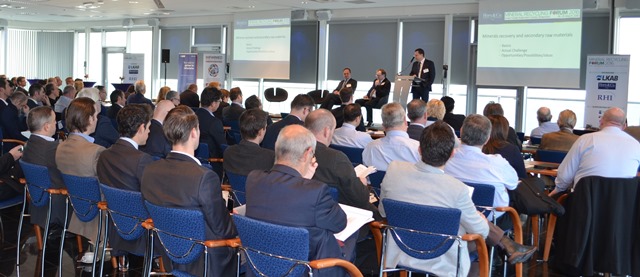

Mineral Recycling Forum 2016 commenced with a most convivial and well-attended Welcome Reception sponsored by LKAB Minerals. Darren Wilson, Chief Operating Officer of LKAB Minerals, warmly welcomed delegates, underlining the importance of this growing sector and LKAB’s commitment to the development of secondary raw materials (the company recently opened a mineral recycling plant in Moerdijk).
During the Forum, thirteen presentations from experts covered a wide range of topics including: industrial mineral life cycles, minerals recovery from waste, recycling refractories, laser-based sorting technology, secondary raw materials from steelmaking, alumina from aluminium salt slag, recycling red mud, cenospheres from fly ash, silica fume sourcing and markets, and phosphorus from waste water.
Here we review just some of the Forum’s highlights.
A reality rain check
Following an introductory presentation by Mike O’Driscoll setting mineral recycling in the context of the industrial minerals supply chain, Didier Jans, Director General, IMA-Europe, presented “Life cycle of industrial minerals: an industrial perspective”.
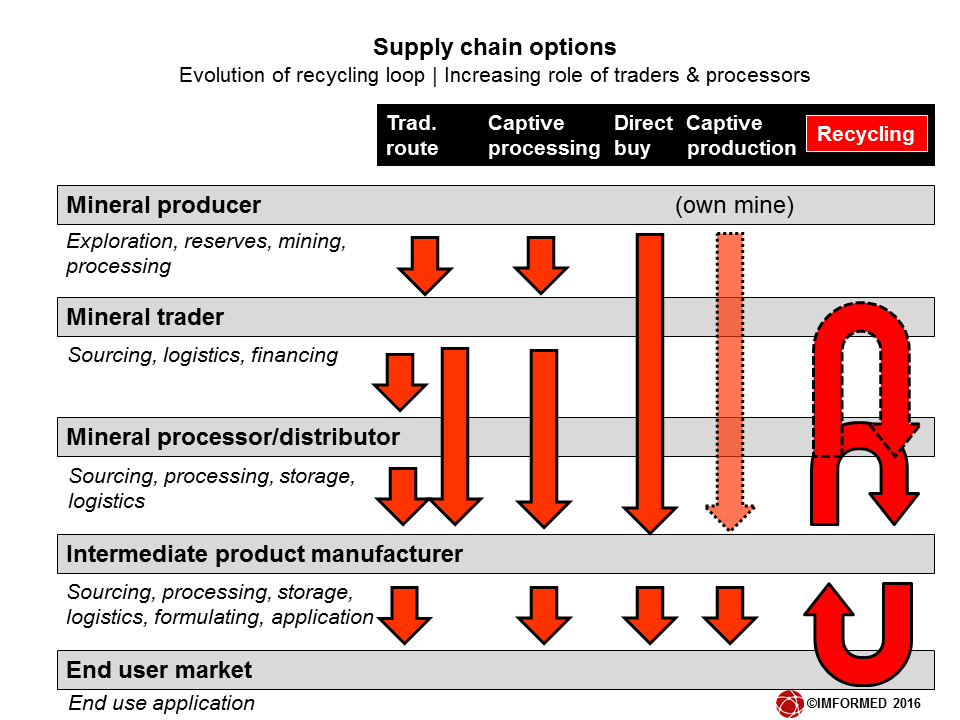
Jans reminded how “industrial minerals are at the basis of manufacturing industry”, providing examples of industrial mineral content in products such as glass, 100%, paper, 50%, paint, 50%, and automobiles, 100-150kg/car.
With a welter of pan-European recycling initiatives and legislation on the go, Jans suggested a “reality rain check” was in order between the European Commission and the industry for the future of recycling.
Core to understanding what makes sense, is an appreciation that there are simple and complex cases in the value chain. Jans illustrated this with reference to the life cycles of the aluminium can, paper, and glass.
He concluded with a review of drivers and limits prolonging the life of minerals, and that there is no one-fits-all recipe for value chains.
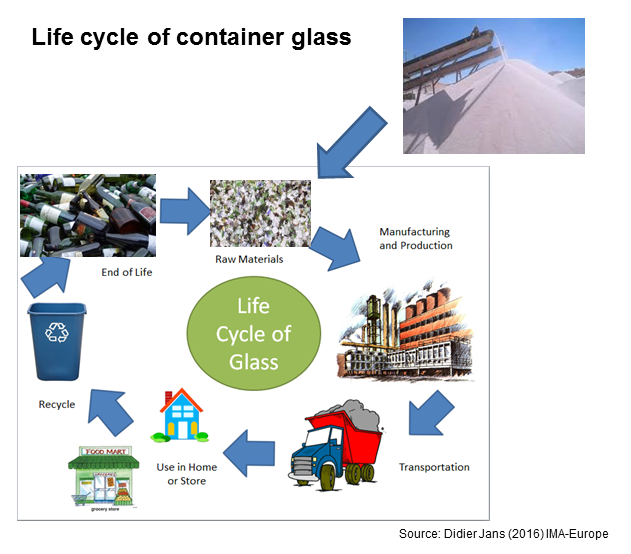

Didier Jans, Secretary General, IMA-Europe makes a point during the panel session, with Nenad Tanasic, Managing Director, Mineralmahlwerk Westerwald Horn GmbH (left) and Mike O’Driscoll, Director, IMFORMED (right).
All materials are equal: no “secondary” stigma
Nenad Tanasic, Managing Director, Mineralmahlwerk Westerwald Horn GmbH & Co KG, directly got into the philosophy of mineral recycling by declaring that we should not brand such products as “secondary raw materials” at all.
In his presentation “Minerals recovery and secondary raw materials”, Tanasic considered we should steer clear of labelling raw materials as “Primary” or “Secondary”, and instead have them branded as “v-type” (virgin raw materials) or “r-type” (raw materials based on used products being recycled).

“There should be no ‘secondary’ raw materials: only virgin and recycled raw materials”, Nenad Tanasic, Managing Director, Mineralmahlwerk Westewald Horn GmbH.
In doing so, the still widely perceived stigma of a used product somehow having a lesser value would be minimised. This was generally received as a commendable move to rightly portray the value of such products. However, during the subsequent discussion, more than one delegate commented that end users testing the material would still require details of the material’s original source.
Tanasic also explained about “downcycling” of recycled materials used in low cost applications, far away from their original use, and “upcycling” of recycled materials used in higher value applications, and even possessing properties absent from v-type raw materials.
The various steps in recycling refractory break-outs were described and Tanasic said: “The big problem in the future
Tanasic also hit on the nub of the recycling business, or the “Actual Challenge” as he described it, ie. the management by the recycling company of the balance between continuous and discontinuous flows of waste material against supply of recycled material flow to end users. He ventured influencing factors on how the latter may shrink while the former grew.
Suggested opportunities for the future include the offering to end users of r- or v- type materials on an equal basis; the development by end users of products incorporating r-type materials, thus enhancing their future recyclability; increasing responsibilities of the recycling companies; and linking the material flows and the parties involved at each stage to co-operate.
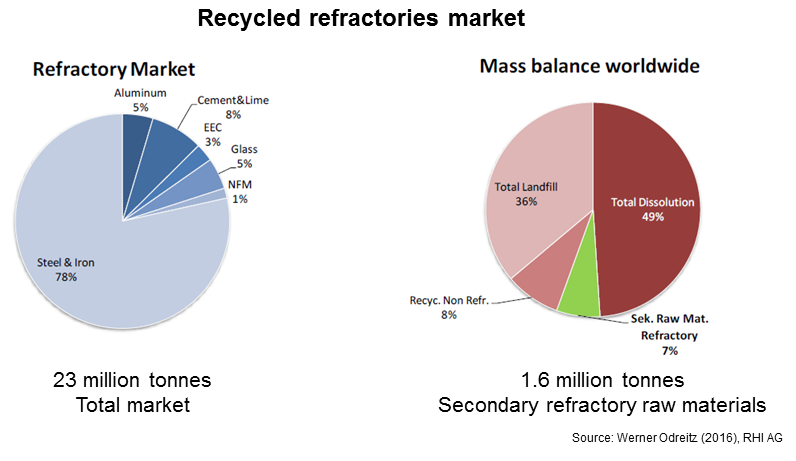
Recycling refractories
Melvyn Bradley, Technical Director, LKAB Minerals, presented the first of four presentations focused on a major source of recycled minerals, waste refractories.
In his presentation “Recycling of spent refractories” Bradley related that there has been a significant increase in usage of recycled refractories over the last ten years, initially driven by environmental considerations and the escalating cost of virgin refractory raw materials. But he also noted that locally sourced recycled material and price stability have also fuelled growth.
Several EU regulatory frameworks, such as EU Waste Shipment Regulations, EU Waste Framework Directive, and REACh were highlighted as requiring more work on definitions to give clarity for the recycling sector.
Bradley summarised LKAB Minerals’ Circle of Life concept: to avoid “spot lots” of secondary raw materials and establish a sustainable operation and develop strategic partnerships. The company’s new Moerdijk plant has 12,000m2 dedicated to recycling.
Spent refractory processing and applications were outlined, as well as LKAB’s recent standardisation of recycled refractory materials into magnesia- and alumina-based products.
Bradley concluded: “The market for recycled materials will continue to grow, while strategic partnerships are critical to maintain the supply chain.” He also added that a strong focus is required to improve sorting techniques.

Werner Odreitz, Purchasing Director, Secondary Raw Materials, RHI AG, delivered his presentation “Recycling refractories from an end user’s viewpoint” with a passion customary to someone devoted to the business for the last 15 years.
He suggested that about 7% of world refractories consumed were recycled for secondary raw materials (SRM), amounting to about 1.6m tonnes.

Werner Odreitz concluded: “It is easy to send spent refractories to landfill, but rising taxes along with environmental fees and increased pressure on our natural resources will leave us with no option but to utilise this vital secondary raw material.”
Refractory markets using RHI’s refractory SRM – at about 100,000 tpa in total – were steel, 79%, cement/lime, 10%, nonferrous metals, 4%, glass, 4%, and others 3%.
Odreitz highlighted the motives and effects of recycling refractories before examining the yield of different refractory materials for recycling from a range of markets and furnace types.
He also underlined the challenge of separating and sorting refractory breakout material whose recyclable yield can be influenced by the type of steel made, and the presence of nozzles, fines, hydrated brick, high alumina castable, and bricks stuck together.
Processing companies have become increasingly important and closer co-operation between the production plant, the processor, and the supplier is necessary to increase the consumption rate of secondary raw materials.
To one of the key areas of technical advancement in mineral recycling: laser-based sorting. Christian Bohling, CEO, Secopta GmbH, explained all in his talk “Laser-Induced Breakdown Spectroscopy (LIBS) in recycling of refractory material outbreak”.
The basics and advantages of using fully automated LIBS in recycling were outlined, described as “universal”, “flexible”, “fast”, and “straightforward”.
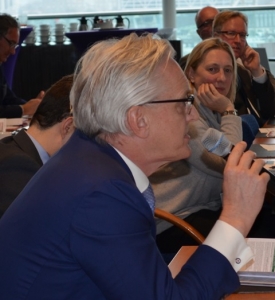
Walther van Oers, Managing Director, Mineralen Kollee, debates an aspect of LIBS technology; there was discussion over the merits of hand-sorting versus automated laser sorting.
Bohling went on to describe using LIBS in refractory recycling, acknowledging challenges in refractories such as heterogeneous structure, many different matrices, and “difficult” conditions, but also offering solutions in LIBS and showing how it can analyse a wide range of materials.
The refractories recycling session concluded with a fine example of material recycling in practice at one of the world’s leading stainless steelmakers, Acciai Speciali Terni, as described by Marc Faverjon, Sales Engineer, Defref SpA in “The circular economy concept at a stainless steel plant: a secondary raw material source of minerals.”
Deref and AST have worked together on a project aimed at no landfill disposal of waste material coming from refractory breakouts, decreased consumption of lime in steel production, metal recovery, and overall sustainability.
The project started in January 2013, and came to fruition in February 2014; in 2015 almost 19,000 tonnes of refractory material was reprocessed from EAF, ladles, and AOD vessels, as well as 1,330 tonnes of steel.
Recovered magnesia and dolomite was reused by AST in slag conditioning, saving an estimated 15,300 tpa of lime consumption, with recovered alumina sold to external outlets.
Refractories trends at MagForum 2016, 9-11 May 2016, Vienna
Keynote discussion panel: Status & outlook for magnesia markets
Refractory market drivers outlook for magnesia Ted Dickson, TAK Consultancy, UK
High purity magnesia raw materials for refractories Sonja Larissegger, Technical Marketing Manager, RHI AG, Austria
Fused magnesia trends and global outlook Asım Bilge, Production Engineer, DBM & FM Production Dept., Kümaş Manyezit San. AŞ, Turkey
Secondary alumina from salt slag
Howard Epstein, Technical Consultant, RVA, presented “Recycled alumina from aluminium salt slag: origins & applications”, explaining the source, nature, market applications and drivers of this recovered alumina product.
RVA essentially processes the salt slag generated from secondary aluminium processing from aluminium scrap, yielding a “secondary” alumina which can be used in non-metallurgical alumina markets.
Approximately one tonne of secondary aluminium produced yields 550kg salt slag, which can yield 300kg of secondary alumina. Potential world production of secondary alumina is about 3.1m tpa.
Epstein outlined key drivers of this recycling loop as including environmental regulations that prohibit landfilling of aluminium salt slag, and lower production costs compared to primary alumina production.
RVA’s product, called Valoxy, contains 67% alumina, and has current and potential use in cement, insulation products, stainless steel slag stabilisation, fire resistant geopolymers, and calcium aluminate steel refining powders.
Epstein highlighted Valoxy use in cement production and as a substitute for borax in stabilising AOD steel slags.
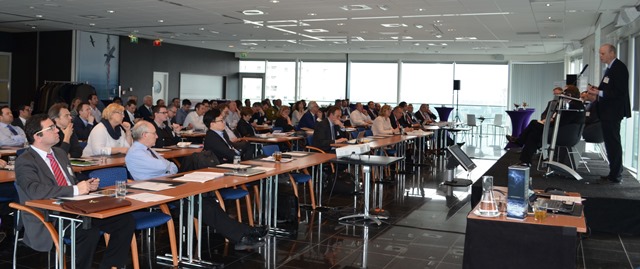
Melvyn Bradley, Technical Director, LKAB Minerals, addresses the audience on recycling refractories.
Red mud source for mineral wool & cement
In “Valorisation of bauxite residue (red mud): in pursuit of a technologically realistic and financially viable process”, Dr Yiannis Pontikes, Senior Researcher, Sustainable Metals Processing & Recycling, KU Leuven, described the progress made over the last decade in red mud processing.
He highlighted the success story of Aluminium de Grece in installing high pressure filter presses to produce a semi-dry product, “Ferro-alumina”, which has since been used in cement, mineral wool, and many other applications.
Pontikes described some of the ongoing research into red mud market applications, and said: “The message to take home is that there is work being done and that reality is region/plant specific.”
The Mud2Metal project was described, showing how rare earth elements can be recovered and from the resulting alumina slag, mineral fibres, aluminate cements, and geopolymers can be processed.
Laser based analysis of slag
Continuing the theme of slags, their analysis using laser-based inline systems was described by Dr Cord Fricke-Begemann, Group Manager, Materials Analysis, Fraunhofer-Institut für Laser Technik ILT in “Laser-based inline analysis of slags and refractories.”
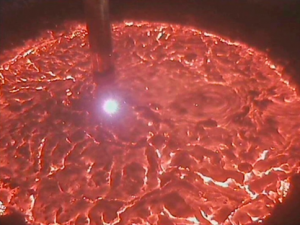
LIBS analysis of liquid slag. Courtesy Dr Cord Fricke-Begemann
The different categories of slags, their sources, and market applications were described. Fricke-Begemann noted: “Their classification as ‘by-product’ or ‘waste’ is not uniform throughout the EU.” This has important implications for their handling and recycling.
The slag chemistry is all-important and dictates its value and potential uses. Inline analysis of liquid slag at voestalpine Stahl Linz was described using LIBS. The challenges in non-destructive identification and sorting of refractories in the REFRASORT project were also described.
Fricke-Begemann concluded: “Inline laser analysis of minerals enables high-grade recycling, and such innovative laser approaches open up new perspectives for the minerals industry.”
Cenospheres from fly ash
One of the well-established SRM over the years has been fly ash. Erwin Grossman, Head of Sales, Mine Feuerfest GmbH, presented “Cenospheres: an overview of their extraction and markets”.
About 97-98% of fly ash from coal-fired power stations is waste, and some 2-3% of fly ash is round and hollow, called cenospheres. Grossman said: “Fly ash quality is directly linked to the coal used. Lower coal quality leads to lower quality fly ash, and consequently, lower quality of cenospheres.”
Grossman explained the different types of cenospheres – grey and white – and how they are traditionally harvested from lagoons.
However, he outlined some disadvantages in this method, such as: contamination through “natural materials”, no control in sinker parts, freezing in winter leads to disruptions in production and supply, and only up to 20% of cenospheres are collected.
In response to this, Mine Feuerfest’s partner, Eko Export, Poland, has built a unique and new production facility to recover and produce white cenospheres in Astana, Kazakhstan. The new 36,000 tpa plant is integrated with its supply source, allowing collection of cenospheres direct from the power plant through a pipeline plug-in.
Silica fume: the fusion by-product
In “Silica fume and its market applications” Dirk Auge, Trader, Cofermin Rohstoffe GmbH & Co. KG, took the audience through the various sources, properties, and applications of silica fume.
Silica fume is a by-product in the carbothermic reduction of high-purity quartz with carbonaceous materials like coal, coke, wood-chips, in electric arc furnaces in the production of silicon, ferrosilicon alloys and fused zirconia.
Silica fume comprises spherical particles less than 1 μm in diameter, and of key significance for market applications, possesses a surface area of approximately 15,000-30,000 m²/kg.
Of particular interest was the story related of RW Silicium, essentially treating silica fume as a waste product many years ago and landfilling a site with the material. Through working with mineral processor KTS-Karlicher Ton-und Schamottewerke Mannheim & Co. KG, Cofermin has been exploiting the former RW Silicium silica fume “deposit” for a range of applications.
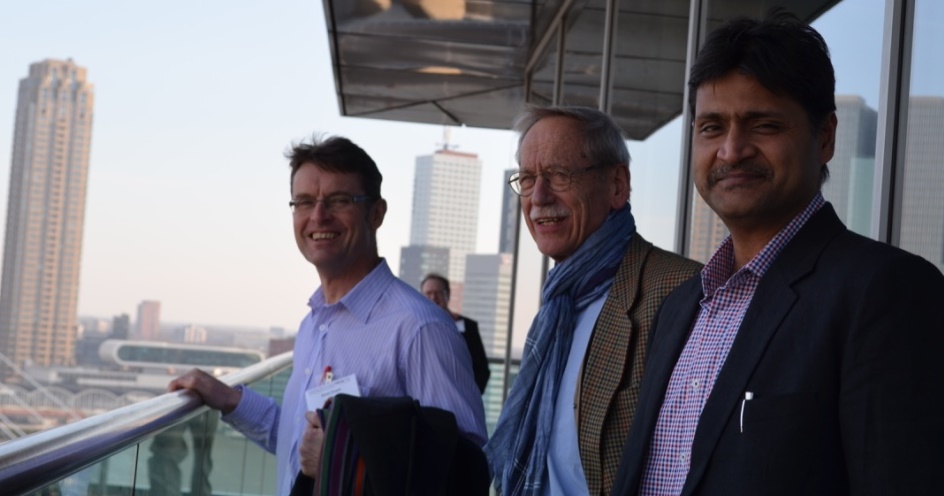
Heady times: delegates take a breather by walking (and braving) the veranda of the conference room, on the Inntel Hotel’s top floor, providing a spectacular view of Rotterdam.
An alternative source of phosphorus for fertiliser
Phosphate rock is not the only source of the vital fertiliser ingredient phosphorus. In “Bridging the gap between nutrient recovery and recycling”, Dr Christian Kabbe, Project Manager, Kompetenzzentrum Wasser Berlin, showed how wastewater and sewage sludge is a relevant and renewable phosphorus resource in a circular economy.
Kabbe explained the hot spots for phosphorus recovery from municipal wastewater, and the status of recovery and recycling options of sewage. Some 11m tpa of dry solids waste are recycled to the EU28 agricultural market, of which 40% is from sewage sludge.
Kabbe concluded with a range of future needs, including sound and real monitoring based data on relevant waste streams (and nutrient species), and a level playing field for both primary and recycled nutrients (legal and economic). “Nutrient recycling is complex and needs multi-sectoral co-operation.” said Kabbe.
IMFORMED is delighted with the success and positive feedback from delegates on Mineral Recycling Forum 2016, and is already looking forward to planning Mineral Recycling Forum 2017 with delegates’ comments and suggestions in mind.
Indeed, we have already begun taking bookings for sponsorships and exhibits, and offers of presentations have been accepted. Please do not hesitate to contact Ismene Clarke for the former, and Mike O’Driscoll for the latter.
A special thank you again to all of our speakers, sponsors, exhibitors, and attendees for making the event such a success. We hope to see you again soon.
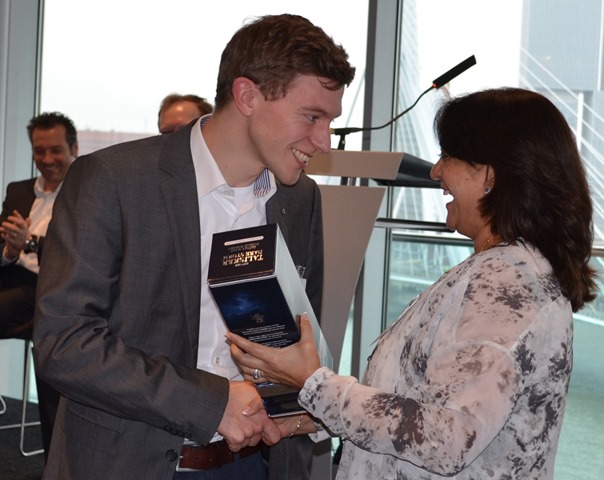
And the lucky winner is….Henning Knapp, Research Assistant, RWTH Aachen University. Congratulations! Henning received his draw prize from Ismene Clarke, Director, IMFORMED.
For more pictures of Mineral Recycling Forum 2016 please go to Gallery
Missed attending Mineral Recycling Forum 2016?
For programme, attendees, pictures, and feedback please go to Past Forums.
A set of presentations (as PDF) maybe purchased: Price £500 – please contact:
Ismene Clarke, T: +44 (0)208 224 0425; M: +44 (0)7905 771 494; E: ismene@imformed.com
Make sure you don’t miss out! Register now!
Mineral Logistics Forum 2016 11-13 April 2016, Rotterdam
MagForum 2016 9-11 May 2016, Vienna
Oilfield Minerals & Markets Forum Houston 2016, 5-7 June 2016, Houston

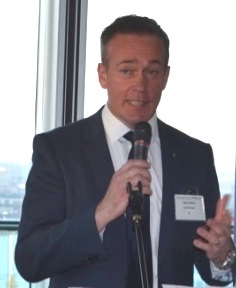
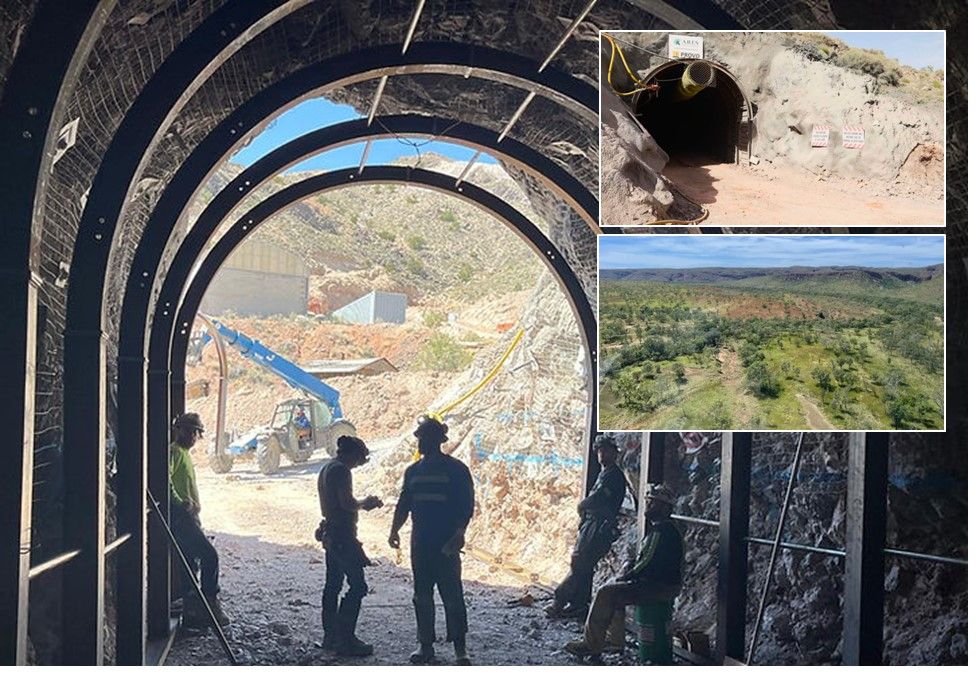
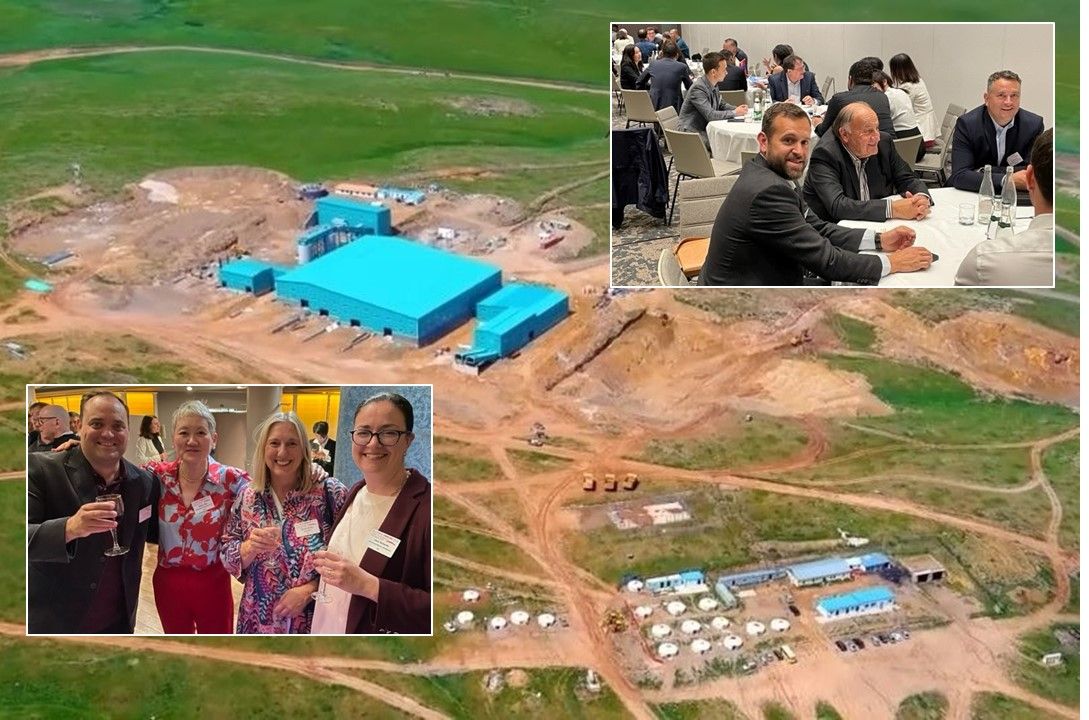

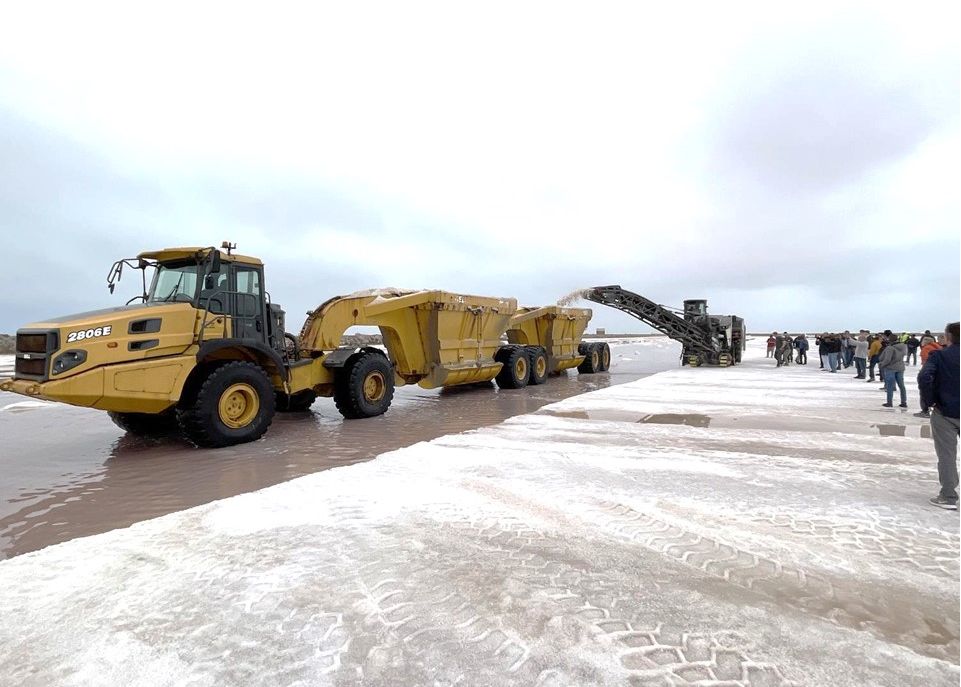

Leave A Comment